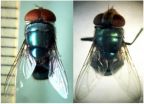(Press-News.org) VIDEO:
This image depicts Chrysomya megacephala larvae on decomposing fish.
Click here for more information.
Non-biting blow fly Chrysomya megacephala is commonly found in dead bodies and is used in forensic investigations to determine the time of death, referred to as the post mortem interval. A report of synanthropic derived form of C. megacephala from Tamil Nadu is provided for the first time based on morphological features and molecular characterization through generation of DNA barcoding. This study, significant in forensic investigations was published in the open access Biodiversity Data Journal.
Chrysomya megacephala is commonly found in corpse in many parts of the world. It is a tremendously abundant species and is used as fish bait in northern and south-west India. It is known to breed in human faeces, decomposed meat and fish as well as in discarded organic materials.
This dipteran fly, therefore, serves as a potential vector of many diseases due to its close association with human dwellings. In general, C. megacephala is considered important in medical, veterinary and forensic sciences. Post mortem interval (PMI) determination is useful in cases of homicide, suicide and accidental or unattended death because of natural causes. An important aspect of calculating the PMI is the accurate and quick identification of the dipteran fly collected from a crime scene.
Behaviour and developmental times of dipteran flies are essential in determining the PMI. Currently, the most common way is to identify dipteran flies for examining the adult stage under a compound microscope. It requires that the larvae collected from a crime scene should be reared until development is complete. The dipteran fly can be identified in the larval form, but if the critical characteristics are small or vary ever so slightly, misidentification is possible.
Morphological identification is difficult within the dipteran flies. A more precise method is to identify the dipteran flies genetically by encoding the collected DNA sequence at mitochondrial cytochrome oxidase gene subunit I (mtCOI). Presently, three forms of C. megacephala are recognized, namely, the normal form (nf), the synanthropic derived form (sdf) and the recently reported feral derived form (fdf).
The normal form is confined to forests of South Pacific Islands while synanthropic derived form has spread around the world from Papua New Guinea. The recently reported feral derived form (fdf) in the forests of the Himalaya, India is morphologically intermediate between normal and synanthropic derived forms. However, the occurrence of the synanthropic derived form of C. megacephala has not been documented in the State of Tamil Nadu, India.
In this context, a report for the first time for C. megacephala (sdf) from Royapuram fishing harbour, Chennai, Tamil Nadu, South East India is significant. A colony of C. megacephala was established from numerous second and third instar larvae collected from decaying fishes. The life expectancy of this fly is 40-45 days. Freshly emerged adults from pupae were identified through morphological and molecular studies.
INFORMATION:
Original Source
Ramaraj P, Selvakumar C, Ganesh A, Janarthanan S (2014) Report on the occurrence of synanthropic derived form of Chrysomya megacephala (Diptera: Calliphoridae) from Royapuram fishing harbour, Chennai, Tamil Nadu, India. Biodiversity Data Journal 2: e1111. doi: 10.3897/BDJ.2.e1111
Mr. P. Ramaraj
Dead body feeding larvae useful in forensic investigations
2014-07-23
ELSE PRESS RELEASES FROM THIS DATE:
Study provides new perspectives on the current Clostridium difficile epidemic
2014-07-23
PASADENA, Calif., July 23, 2014 — More than 80 percent of hospitalized patients who tested positive for Clostridium difficile were tested outside the hospital or within the first 72 hours of hospitalization, suggesting that settings outside of the hospital may play key roles in the identification, onset and possible transmission of the disease, according to a new Kaiser Permanente study published today in the journal Mayo Clinic Proceedings.
The study provides new insight into the contagious and potentially deadly infection also known as C. diff, a bacterium most often ...
Nano-sized chip "sniffs out" explosives far better than trained dogs
2014-07-23
Security forces worldwide rely on sophisticated equipment, trained personnel, and detection dogs to safeguard airports and other public areas against terrorist attacks. A revolutionary new electronic chip with nano-sized chemical sensors is about to make their job much easier.
The groundbreaking nanotechnology-inspired sensor, devised by Prof. Fernando Patolsky of Tel Aviv University 's School of Chemistry and Center for Nanoscience and Nanotechnology, and developed by the Herzliya company Tracense, picks up the scent of explosives molecules better than a detection dog's ...
Statin use decreases the risk of Barrett's esophagus
2014-07-23
Bethesda, MD (July 23, 2014) — Statins, a class of drugs commonly used to lower cholesterol levels, significantly reduce a patient's risk of developing Barrett's esophagus, according to a new study in Gastroenterology1, the official journal of the American Gastroenterological Association. Obese patients experienced the greatest level of risk reduction with statin use.
"Patients who received statins had a 43 percent reduction in the odds of having Barrett's esophagus compared to non-users," said study author Hashem B. El-Serag, MD, MPH, from the Houston VA Medical Center ...
Rosemary and oregano contain diabetes-fighting compounds
2014-07-23
The popular culinary herbs oregano and rosemary are packed with healthful compounds, and now lab tests show they could work in much the same way as prescription anti-diabetic medication, scientists report. In their new study published in ACS' Journal of Agricultural and Food Chemistry, they found that how the herbs are grown makes a difference, and they also identified which compounds contribute the most to this promising trait.
Elvira Gonzalez de Mejia and colleagues point out that in 2012, type-2 diabetes affected more than 8 percent of Americans and cost the country ...
The geography of the global electronic waste ('e-waste') burden
2014-07-23
As local and national governments struggle to deal with ever-growing piles of electronic waste (or "e-waste"), scientists are now refining the picture of just how much there is and where it really ends up. Published in the ACS journal Environmental Science & Technology, their study found that nearly a quarter of e-waste that developed countries discard floods into just seven developing countries — with major potential health risks for the people who live there.
Knut Breivik and colleagues note that the export from developed to developing regions of e-waste — everything ...
Researchers unlock the protein puzzle
2014-07-23
By using brightly hued dyes, George Mason University researchers discovered an innovative way to reveal where proteins touch each other, possibly leading to new treatments for cancer, arthritis, heart disease and even lung disease.
George Mason researchers unraveled the mystery of deciphering the contact points where proteins touch each other. "One protein interlocks with another protein like adjacent pieces in a jigsaw puzzle, and this sends a signal down the line to the next protein," says Lance Liotta, co-director of the Mason-based Center for Applied Proteomics and ...
A new approach in the search for extraterrestrial intelligence: targeting alien polluters
2014-07-23
Humanity is on the threshold of being able to detect signs of alien life on other worlds. By studying exoplanet atmospheres, we can look for gases like oxygen and methane that only coexist if replenished by life. But those gases come from simple life forms like microbes. What about advanced civilizations? Would they leave any detectable signs?
They might, if they spew industrial pollution into the atmosphere. New research by theorists at the Harvard-Smithsonian Center for Astrophysics (CfA) shows that we could spot the fingerprints of certain pollutants under ideal conditions. ...
An increase in temperature by 2050 may be advantageous to the growth of forage plants
2014-07-23
A 2°C increase in temperature around the world by 2050, according to one of the scenarios predicted by the Intergovernmental Panel on Climate Change (IPCC), may be advantageous to the physiology and the biochemical and biophysical processes involved in the growth of forage plants such as Stylosanthes capitata Vogel, a legume utilized for livestock grazing in tropical countries such as Brazil.
The conclusion is from a study carried out by researchers in the Department of Biology at the Ribeirão Preto Faculty of Philosophy, Sciences and Languages and Literature at the University ...
New method for reducing tumorigenicity in induced pluripotent stem-cell based therapies
2014-07-23
New Rochelle, NY -- The potential for clinical use of induced pluripotent stem cell (iPSC) technology for transplant-based therapeutic strategies has previously been hindered by the risk of dysregulated cell growth, specifically the development of tumors. The ability to use etoposide treatment to halt teratoma formation in iPSCs for the treatment of heart disease, specifically acute myocardial infarction, is demonstrated in an article in Stem Cells and Development, a peer-reviewed journal from Mary Ann Liebert, Inc., publishers. The article is available on the Stem Cells ...
Research charts the ecological impact of microbial respiration in the oxygen-starved ocean
2014-07-23
A sulfur-oxidizing bacterial group called SUP05 will play an increasingly important role in carbon and nutrient cycling in the world's oceans as oxygen minimum zones expand, according to research published this week in the Proceedings of the National Academy of Sciences.
University of British Columbia researchers plumbed the depth of a seasonally anoxic fjord, Canada's Saanich Inlet, to chart how microbial community metabolism changes as oxygen minimum zones form.
"Our study paints a very detailed picture of how SUP05 — a bacterial group related to gill symbionts of ...




